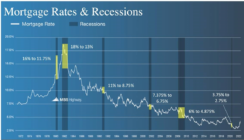Are you curious about how to save money on your home loan? Have you heard about the possibility of buying down your interest rate but aren’t sure what it entails or how much it costs? In the simplest terms, a mortgage rate buydown involves paying an upfront fee to reduce your mortgage interest rate and lower your monthly payments.
In this comprehensive guide, we’ll explore the different types of rate buydowns – including seller-paid buydowns, lender-paid buydowns, temporary buydowns, and permanent rate buydowns – and dive into their costs and benefits.
Understanding Mortgage Rate Buydowns
A mortgage rate buydown is an arrangement where an initial payment is made to achieve a lower interest rate on your mortgage. This initial payment can be made by you, the buyer, or even the seller or lender. A larger upfront payment results in lower monthly mortgage payments. This technique can result in significant savings over the lifetime of your loan.
It’s crucial to understand that this approach requires an upfront investment, which might not be feasible for everyone. The party who agrees to pay for the buydown and the amount they pay can significantly impact your mortgage’s overall cost.
There are a few types of mortgage rate buydowns that we will cover in this blog:
- Temporary Rate Buydowns: These reduce your interest rate for a short period of time, usually 1-3 years.
- Permanent Rate Buydowns: These lower your interest rate for the entire life of the mortgage.
- Seller-Paid Rate Buydowns: The seller pays to lower your interest rate. The seller can pay for a temporary buydown or they can offer a closing cost credit which you can apply towards the cost of a permanent rate buydown.
- Lender-Paid Rate Buydowns: The lender covers the cost to buy down your interest rate
What Does It Cost to Buy Down Your Interest Rate?
When considering a rate buydown, the cost is usually measured in ‘points.’ One point equals 1% of your loan amount.
For example, on a $300,000 mortgage, one point is $3,000. Generally, purchasing one point reduces your interest rate by about 0.25%. The key is balancing the upfront cost with future savings.
The more points you decide to purchase upfront, the lower your interest rate will be. However, it’s essential to recognize that while buying more points can lead to lower monthly payments, it also means a higher initial investment. The balance between upfront costs and future savings is a vital consideration when deciding how many points to buy, if any, and whether the buydown will cost you, the seller, or the lender.
View mortgage rates for
April 27, 2024
Seller-Paid Rate Buydowns
A seller-paid temporary rate buydown occurs when the home seller agrees to pay upfront to lower your mortgage’s interest rate for a period of time (1-3 years).
This option is particularly attractive if you’re looking at a long-term mortgage. The buydown funds will never go away, even if rates drop and you refinance before the end of the buydown period. Any remaining buydown funds at the time of a refinance will be applied to your outstanding principal loan balance.
There are a few common buydown scenarios that are used frequently:
1-1 Buydowns
In a 1-1 buydown, the interest rate on the mortgage is reduced by 1% for the first year. After this period, the rate returns to the original, higher rate agreed upon in the mortgage note. This type of buydown offers temporary relief in the initial year of the loan.
2-1 Buydowns
A 2-1 buydown reduces the mortgage interest rate by 2% in the first year and by 1% in the second year. Starting in the third year, the interest rate reverts to the original rate set in the mortgage note agreement. This approach gives a two-year period of reduced payments, easing into the full rate gradually.
3-2-1 Buydowns
In a 3-2-1 buydown, the interest rate is reduced by 3% in the first year, 2% in the second year, and 1% in the third year. From the fourth year onwards, the interest rate returns to the standard rate specified in the mortgage note. This method provides a step-down approach, easing the borrower into the full mortgage rate over a three-year period.
Lender-Paid Temporary Rate Buydowns
With lender-paid buydowns, the lender covers the cost for the temporary rate buydown.
Permanent Rate Buydowns
Permanent rate buydowns involve an upfront fee (“points”) for a reduced interest rate. While the initial cost can be significant, the long-term savings, especially on 30-year loans, can be immense. This option is ideal for those who can manage the upfront expense and plan to stay in their home long-term.
Risks of Permanent Rate Buydowns
While permanent rate buydowns are popular for their long-term savings potential, they come with notable risks. The initial costs can be significant. If rates drop and you refinance into an even lower rate, or sell your home sooner than planned, the initial investment may not pay off.
Furthermore, a large sum tied into the home limits financial flexibility, potentially hindering your ability to manage unexpected expenses or seize investment opportunities. In a falling interest rate environment, you could end up with a rate higher than the market average. It’s important to weigh these considerations carefully before opting for a permanent rate buydown.
JVM’s mortgage experts can help you navigate rate buydowns and provide scenarios to see if a permanent buydown makes sense for you. Contact JVM Lending with any questions you might have and we’d be happy to help.
Frequently Asked Questions
What is a mortgage rate buydown?
A mortgage rate buydown is an arrangement where an upfront fee is paid to permanently or temporarily reduce the interest rate on your mortgage. This results in lower monthly mortgage payments for a specified period of time or for the entire duration of the loan.
How does a rate buydown work?
In a rate buydown, you pay for points upfront, where one point typically equals 1% of the loan amount. This payment reduces your interest rate, which in turn decreases your monthly mortgage payments. There are also options for temporary rate buydowns, which lower your interest rate for a set period of time. Temporary rate buydowns can be paid for by the seller or the lender.
Are rate buydowns worth it?
Whether a buydown is worth it depends on your financial situation, how long you plan to stay in the home, and the terms of the buydown. It’s a good idea to calculate the long-term savings against the upfront cost to discover at what point you will break even (the point at which the monthly savings will have paid you back for the up-front investment). Consulting with a mortgage expert like JVM Lending can help you make an informed decision.
Does a rate buydown affect my credit score?
No, buying down your rate doesn’t directly affect your credit score. However, a lower monthly payment can make it easier to manage your finances, which may positively impact your credit score over time.
Can I get a rate buydown on an adjustable-rate mortgage (ARM)?
Yes, rate buydowns can be applied to ARMs, but the specifics can vary. It’s important to discuss this with your lender to understand how it can work with your particular mortgage.
Is A Rate Buydown Right For You?
Choosing the right mortgage rate buydown is a decision that hinges on your long-term housing plans and financial health. As mentioned above,it’s important to balance the upfront costs with the long-term benefits.
For expert guidance tailored to your unique financial situation and goals, reach out to JVM Lending. Our team is here to help you navigate these decisions, ensuring you choose a path that not only secures a favorable interest rate but also supports your overall financial well-being and homeownership dreams.
Contact JVM Lending today to explore your options at (855) 855-4491 or [email protected].











